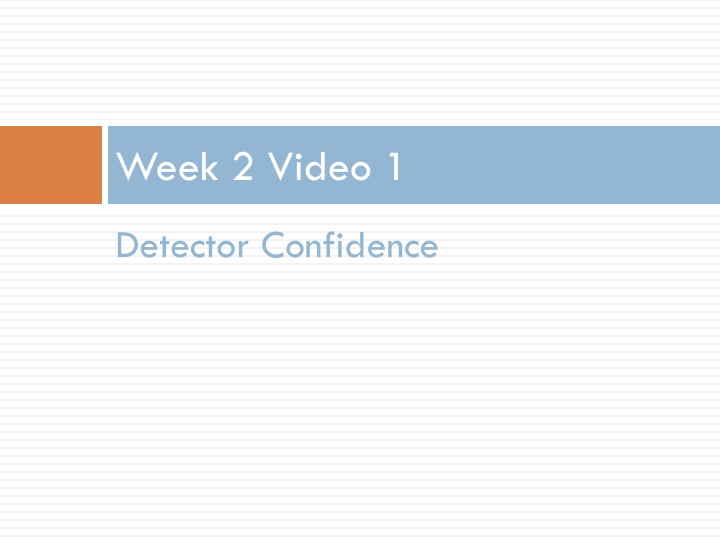
Detector Confidence for Predictive Models
Explore the concept of detector confidence in predictive models, where knowing the certainty of predictions can lead to more informed decision-making. Learn how to utilize confidence levels for gradated interventions and make strategic decisions based on cost-benefit analysis. Dive into examples illustrating the impact of correctly and incorrectly applied interventions on learning outcomes, and understand how to calculate the expected value of interventions.
Download Presentation

Please find below an Image/Link to download the presentation.
The content on the website is provided AS IS for your information and personal use only. It may not be sold, licensed, or shared on other websites without obtaining consent from the author. If you encounter any issues during the download, it is possible that the publisher has removed the file from their server.
You are allowed to download the files provided on this website for personal or commercial use, subject to the condition that they are used lawfully. All files are the property of their respective owners.
The content on the website is provided AS IS for your information and personal use only. It may not be sold, licensed, or shared on other websites without obtaining consent from the author.
E N D
Presentation Transcript
Week 2 Video 1 Detector Confidence
Classification There is something you want to predict ( the label ) The thing you want to predict is categorical
It can be useful to know yes or no The detector says you don t have Ptarmigan s Disease!
It can be useful to know yes or no But it s even more useful to know how certain the prediction is
It can be useful to know yes or no But it s even more useful to know how certain the prediction is The detector says there is a 50.1% chance that you don t have Ptarmigan s disease!
Uses of detector confidence Gradated intervention Give a strong intervention if confidence over 60% Give no intervention if confidence under 60% Give fail-soft intervention if confidence 40-60%
Uses of detector confidence Decisions about strength of intervention can be made based on cost-benefit analysis What is the cost of an incorrectly applied intervention? What is the benefit of a correctly applied intervention?
Example An incorrectly applied intervention will cost the student 1 minute Each minute the student typically will learn 0.05% of course content A correctly applied intervention will result in the student learning 0.03% more course content than they would have learned otherwise
Expected Value of Intervention 0.03*Confidence 0.05 * (1-Confidence) 0.04 0.03 0.02 Expected Gain 0.01 0 0 0.1 0.2 0.3 0.4 0.5 0.6 0.7 0.8 0.9 1 -0.01 -0.02 -0.03 -0.04 -0.05 Detector Confidence
Adding a second intervention 0.05*Confidence 0.08 * (1-Confidence) 0.06 0.04 0.02 Expected Gain 0 0 0.1 0.2 0.3 0.4 0.5 0.6 0.7 0.8 0.9 1 -0.02 -0.04 -0.06 -0.08 -0.1 -0.12 Detector Confidence
Intervention cut-points 0.06 STRONGER 0.04 FAIL SOFT 0.02 0 Expected Gain 0.3 0.4 0.5 0.6 0.7 0.8 0.9 -0.02 -0.04 -0.06 -0.08 -0.1 -0.12 Detector Confidence
Alternative approach Cost-sensitive classification You tell the algorithm that false positives and false negatives have a different cost For instance, fitting a model to try to minimize an adjusted RMSE that weights FP and FN differently Rather than just RMSE In this case, you are adjusting the predictions themselves rather than your decision thresholds Can be applied to most modern classification algorithms
Uses of detector confidence Discovery with models analyses When you use this model in further analyses We ll discuss this later in the course Big idea: keep all of your information around
Confidence can be lumpy For example, a tree might only give you confidences 100%, 66.67%, 50%, 2.22% This isn t a problem per-se But some implementations of standard metrics (like AUC ROC) can behave oddly in this case We ll discuss this later this week Common in simpler, earlier-generation classifiers
Confidence Almost always a good idea to use it when it s available Not all metrics use it, we ll discuss this later this week
Confidence about your confidence? Recent methods make it possible to estimate the variance/SD around a confidence value, and 95% confidence intervals around a prediction (Gal & Ghahramani, 2015; Hu & Rangwala, 2019) Not widely used as of this writing, but there are many cases where this could be useful
Risk Ratio A good way of analyzing the impact of specific predictors on your prediction
Risk Ratio Used with binary predictors Take predictor P ?? =??????????? ? ?? ? = 1 ??????????? ? ?? ? = 0
Risk Ratio: Example Students who get into 3 or more fights in school have a 20% chance of dropping out Students who do not get into 3 or more fights in school have a 5% chance of dropping out ?? =??????????? ? ?? 3??? ??=1 ??????????? ? ?? 3??? ??=0 = 0.2 0.05 = 4 The Risk Ratio for 3+ fights is 4 You are 4 times more likely to drop out if you get into 3 or more fights in school
Risk Ratio: Notes You can turn numerical predictors into binary predictors with a threshold Like our last example! Clear way to communicate the effects of a variable on your predicted outcome
Next lecture Diagnostic metrics part 1
